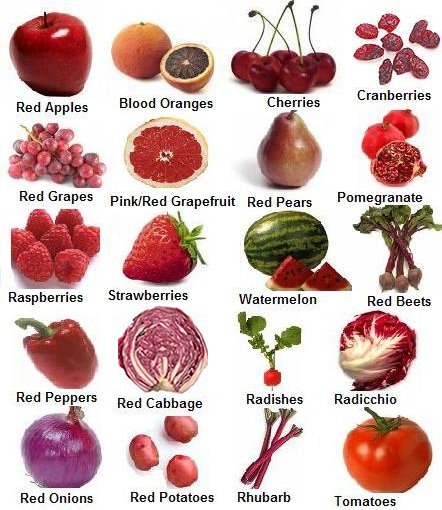
In this list of fruits and vegetables, you can see how many health benefits of fruits and vegetables exist, and why you should eat as many as you can every day. They are low in fat, calories, and sodium, have no cholesterol, and are high in fiber.
Fiber from fruits and vegetables helps fill you up so don't feel like eating more, and it also helps move the digestive process along. Of course, these foods are also full of vitamins and minerals that provide your body with energy.
Most people eat too few on this list of fruits and vegetables, both in quantity a day and in variety. The most consumed vegetables in America are potatoes, lettuce, and tomatoes. The people who eat the most vegetables and fruits in the USA have the lowest risk for chronic diseases. Also, those people are less likely to need vitamins and supplements to have a healthy diet since the vegetables and fruits provide all the nutrition they need.
The list of fruits and vegetables shows the phytochemicals, which are chemicals that come from plants and provide color to the food. There are more than 12,000 phytochemicals in nature, and eating fruits and vegetables, rather than using supplements, is the best way to make sure you are getting enough of them in your diet. Each color food has a different type of phytochemical that helps your immune system function properly.
We are going to use the rainbow's help to show the benefits of nature's foods. Since the same chemical gives the food its color, typically the foods of that color have many of the same healthful components.
You will notice that some of the benefits and some of the colors overlap, so don't be too stringent on getting one of each color. Just eat a great variety. Also, fruits and vegetables do not have just one vitamin, as we commonly believe. They are a mix of several vitamins and minerals.
The phytochemicals in red foods are carotenoids and anthocyanin. One of the most abundant carotenoids is lycopene. Lycopene helps reduce damage from free radicals in your body and it also prevents heart disease, stroke, muscular degeneration, cancer, prostrate cancer, and reduces the skin damage from the sun. These red foods help memory function, urinary tract health, and makes your heart healthy. Red fruits and vegetables are also often very high in vitamin C, which helps encourage cellular renewal in your body.

Carotenoids are the powerful phytochemical in orange foods, and they are what give the foods their color. Carotenoids repair DNA and help prevent cancer and heart disease, as well as strengthening our vision. These orange foods also give us the right amount of potassium and vitamin A, which keeps our eyes and skin healthy, and protects against infections. They are also known to boost the immune system because of the vitamin C content in many of them. Some of these also cross over with the health benefits of the yellow foods below.

Yellow foods are high in antioxidants like vitamin C. Vitamin C keeps our teeth and gums healthy, helps to heal cuts, improves the mucus membranes (like when we have colds), helps to absorb iron, prevents inflammation, improves circulation, and therefore prevents heart disease. They also reduce the risk of prostate cancer, lower blood pressure, lowers LDL cholesterol (the bad cholesterol), promote healthy joints, promote collagen formation, encourage pH balance of the body, boost the immune system and fight harmful free radicals in the body.

Most green foods consist of an array of vegetables: spinach, broccoli, artichokes, asparagus, celery, peas, green beans, green peppers and a variety of leafy greens, avocado, pears, grapes and apples. These foods have the phytochemicals sulforaphane and indoles, which both prevent cancer. They are also good for the circulatory system and have good vitamin B and minerals. On this list of fruits and vegetables, the vitamin K in green foods also helps with vision, and with maintaining strong bones and teeth. Some of the yellower green vegetables have carotenoids lutein and zeaxanthin that help to prevent cataracts and eye disease, as well as osteoporosis.

The strong phytochemical in these whitish/greenish vegetables is called allicin and allium, which create an anti-bacterial, anti-fungal, and anti-viral chemical environment in your body. Some white foods prevent cancer and heart disease, and lower cholesterol levels. Celery is often dubbed as a useless vegetable because it has no calories, but it does have minerals like good sodium that help keep the joints healthy. The selenium in mushrooms helps prevent cancer and keeps your body in balance. Everything on this greenish/white list of fruits and vegetables helps maintain low cholesterol levels in your body as well as a healthy heart.

Blue and purple produce have many different nutrients including, lutein, zeaxanthin, resveratrol, Vitamin C, fiber, flavonoids, ellagic acid, and quercetin. The blue, indigo, and violet list of fruits and vegetables are great for their anti-aging properties. These foods have tons of antioxidants, specifically anthocyanins and phenolics. Some blue and purple fruits and vegetables are also really high in vitamin C. Anything in this category will help improve circulation and prevent blood clots, so they are great for the heart and can help prevent heart disease. They are also known to help memory function and urinary tract health and to reduce free radical damage.

Please feel free to keep in touch with us about any of your business related requirements/queries. Please note that we specialize in dried fruits and vegetables and also dried fish varieties from Uganda. We would like to offer our products to your company. Our supervisor will contact you for further discussion at a time convenient to you.